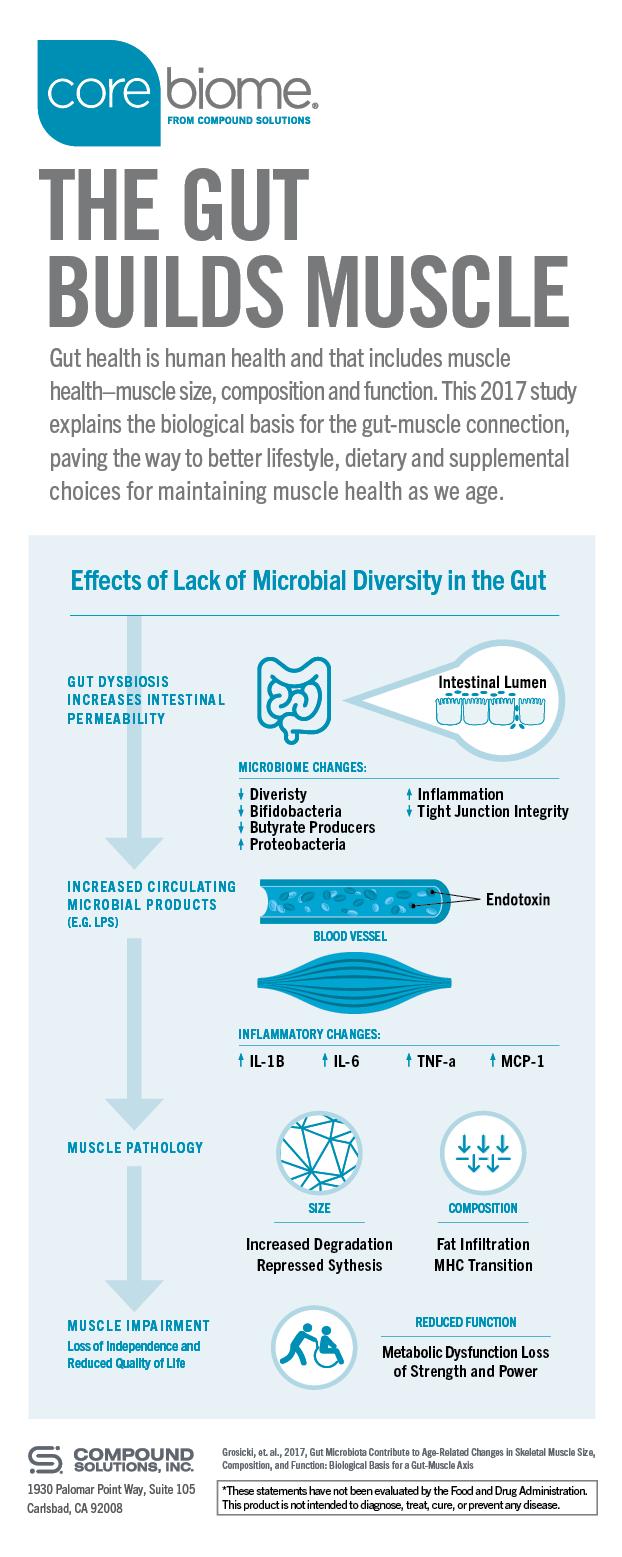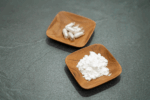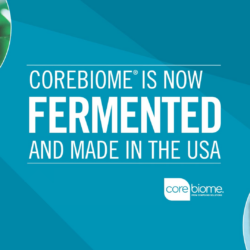The Gut Builds Muscle

It’s not all about protein.
Protein consumption has been on a tear for a decade, and it continues to grow. Not just whey, but vegan proteins, collagen, and now fermented and “air protein”. But don’t you just want to eat like a normal person? The good news is that building muscle is not all about protein. You can actually eat fiber too!
In a 2025 study in post-menopausal women, the researchers wrote: “Butyrate protects skeletal muscle… stimulates muscle regeneration, inhibits muscle breakdown, enhances insulin sensitivity… these combined effects contribute to increased muscle mass, strength and endurance.” Most experts recommend an average person consume about 10-35% of calories as protein.1
Dr. Gabrielle Lyon advocates for more protein consumption. But protein bars, shakes, protein brownies and cookies aren’t the only solutions.
But What About the Gains You’ve Made in the Gym?
Well, we understand that athletes and older Americans need more protein than the average individual. And now those on semaglutide or tirzepatide (Ozempic® or Wegovy® ) really need protein given significant losses in muscle mass. We all want to improve body composition by gaining muscle and losing fat. But interestingly enough, protein is NOT the lone determinant of muscle gain or loss. A large part of that role depends on the health of our gut. Yes, our gut health influences muscle protein synthesis.
Being “healthy” generally means a diverse gut microbiome. In a study in bodybuilders with high protein, low fiber diets, gut microbial diversity declined.2 But you might be wondering whether diversity matters if your muscle and body composition are great.
Here’s Why Gut Microbiome Diversity Still Matters

A lack of diversity results in gut dysbiosis (an imbalance of gut bacteria). Dysbiosis results in gut permeability. Gut permeability can lead to an unhealthy inflammatory response that reduces muscle size, leads to poor body composition, and eventually impairs muscle gain and function.
Because those on Ozempic® and Wegovy® often have altered diets with less protein consumption & higher carb consumption (inpercentage terms), there is more gut dysbiosis. Bioavailable butyrate is a key component of the solution. See pictorial representation to the right.
Short chain fatty acids (SCFAs) are critical to maintaining muscle mass. In fact, butyrate in the gut may contribute just as much to net protein balance as protein intake.6
Net Protein Balance = Muscle Protein Synthesis – Muscle Protein Breakdown
A 2018 study in an animal model showed improved muscle growth by supplementing with a unique and bioavailable form of butryate.3 This study showed a host of muscle and metabolic benefits when germ-free mice were supplemented with short chain fatty acids. And another study showed that age-related muscle loss may occur as a function of butyrate availability.4
Butyrate may contribute just as much to net protein balance as protein intake. Butyrate is produced in the body from fermenting fiber and resistant starches in the colon.
We synthesize less muscle protein as we age, which leaves us with lower cardiorespiratory fitness, declines in skeletal muscle size and function, and undesirable changes in body composition. Synthesizing less muscle protein as we age is called ‘anabolic resistance.’
Because Leucine is the anabolic trigger, the antidote to anabolic resistance has largely been to ‘add more Leucine’ due to our ‘more protein’ mindset. Over and over again, we try to overcome this anabolic resistance by simply adding more protein ‘fuel.’
But anabolic resistance may not be a function of insufficient protein intake as much as previously thought. Anabolic resistance is more a function of the gut microbiome (i.e., SCFAs like CoreBiome® and TriBiome™ and insulin sensitivity).5
So, what are some potential solutions? These researchers suggest starting with improving butyrate status. That can be done through ingesting resistant starches, patent-pending TriBiome™, or a unique and patented butyrate called CoreBiome®.
Not any butyrate works in humans. Sodium butyrate is largely absorbed in the stomach while a patented and bioavailable butyrate, called CoreBiome® nourishes the whole gut from small to large intestine.
Potential Solutions
- Keep protein intake as-is and work in more fiber and resistant starches.
- Substitute some protein intake for more fiber, polyphenols and resistant starches.
- Supplement with CoreBiome® , a bioavailable and patented form of butyrate, or ReBiome™, a bioavailable and patent-pending form of acetate.
- Adding fiber, resistant starches and polyphenols to a diet is a smart way to maintain and help build muscle, as well as to improve health overall.
- Supplementing with CoreBiome® or ReBiome™ may add more fuel to help you reach your goals faster.
Muscle Supplement Formulation
Below are several ways to re-imagine formulation for the Gut-Muscle Connection
Old Formulas
Whey protein shakes
Protein bars
Vegan protein shakes
BCAAs
EAAs
New Formulas
When protein + Rebiome™ + resistant starches
CoreBiome® + Vitamin D3 + epicatechin + zinc
CoreBiome® + ReBiome™ + Rējen™
Baobab fiber (as Fibriss™) + resistant starch + tart cherry extract
Baobab fiber (as Fibriss™) + resistant starches
Nut butters and nut butter bars + added fibers and resistant starches
Shakes and pancake mixes with resistant starches like potato, pea, green banana, cassava and more
REFERENCES
- Harvard T.H. Chan School of Public Nutrition, The Nutrition Source: Protein
- He, Jin, et. al, 2020, International Journal of Molecular Sciences, Short-Chain Fatty Acids and Their Association with Signalling Pathways in Inflammation, Glucose and Lipid Metabolism
- Murray, R. L., et. al, 2018, The Physiological Society, Dietary tributyrin, an HDAC inhibitor, promotes muscle growth through enhanced terminal differentiation of satellite cells
- Grosicki, G. J., et. al, 2017, National Library of Medicine, Gut Microbiota Contribute to Age-Related Changes in Skeletal Muscle Size, Composition, and Function: Biological Basis for a Gut-Muscle Axis
- Watson, Matthew D., et. al., 2021, MDPI: Nutrients, Evidence for the Contribution of Gut Microbiota to Age-Related Anabolic Resistance
- Lahiri, S., et. al, (2019). Science Translational Medicine, The gut microbiota influences skeletal muscle mass and function in mice





